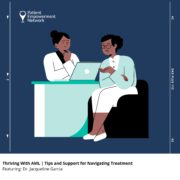AML Clinical Trial Participation Disparities | Impact on Access, Outcomes, and Inclusion Strategies
AML Clinical Trial Participation Disparities | Impact on Access, Outcomes, and Inclusion Strategies from Patient Empowerment Network on Vimeo.
What are AML clinical trial disparities, outcomes, and solutions for inclusion? Expert Dr. Sara Taveras Alam from UTHealth Houston discusses patient factors that impact access, underrepresented patient groups, and patient advice for improving clinical trial access.
[ACT]IVATION Tip
“…inquire if there are clinical trials available at the institution where you’re being cared for, not all institutions do have clinical trials available, and that is okay, but you should be informed and given the opportunity to look into other facilities if clinical trials are available and have the ability to do so.”
Related Resources:

Advancements in AML Treatment | Tailoring Therapies to Individual Patients |

AML Diagnosis | Exploring Bone Marrow Biopsy and Alternatives |

|
Transcript:
Lisa Hatfield:
Dr. Taveras, so this is kind of a three-part question regarding disparities in acute myeloid leukemia. So what are the disparities in clinical trial participation among AML patients, and how do these disparities affect access to innovative treatments and outcomes, and then kind of a third part to this question, how can efforts be made to increase diversity and inclusion and clinical trials for AML?
Dr. Sara Taveras Alam:
Thank you. This is a very important question. Unfortunately, disparities exist in the outcome of AML patients based on different factors, social-economic factors, racial factors, ethnicity, and unfortunately, it has been proven that in clinical trials, the non-Hispanic white population is the predominant population study, so unfortunately, our African Americans or Black patients and our Hispanic patients are underrepresented, and this may impact whether or not the treatments that are getting put, being studied and being utilized in AML patients are appropriate for these patients who were not included on the clinical trials.
I do see that there is an intentional effort to recruit patients from minority groups in institutions where trials are available; however, one caveat is that unfortunately, some of those underrepresented populations don’t necessarily have access to the institutions that are leading the clinical trials. I’m in Houston, and we actually have a county system here in Houston, where leukemia trials are available, and that is really a blessing, because it’s not something that is very common. So throughout my training, when I did go to a county hospital, I was able to see Hispanic patients and African American patients being given the opportunity to participate in clinical trials that may impact the long-term treatment of other patients and those treatments being studied in the population that was using them.
My activation tip for this question is to inquire if there are clinical trials available at the institution where you’re being cared for, not all institutions do have clinical trials available, and that is okay, but you should be informed and given the opportunity to look into other facilities if clinical trials are available and have the ability to do so.










